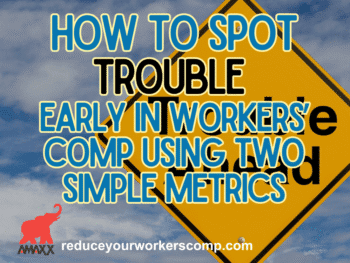The purpose of the waiting period is to eliminate the administrative work involved for the claims handler in paying an employee for a very short period of time. The purpose of the retroactive period is to pay the employee indemnity benefits for all time missed from work when the claim is significant enough to cause the employee to be off work a greater period of time.
Every employee injured on the job knows workers’ compensation pays the medical bills and pays indemnity benefits. However, when an employee is injured and talks to the work comp adjuster for the first time, the employee is almost always dismayed to hear there is a waiting period before indemnity benefits are paid for time missed from work. There is no waiting period for medical benefits.
Click Link to Access Free PDF Download
“How To Avoid, Manage, And Win Workers’ Comp Claim Litigation”
The first question the work comp adjuster hears from the employee is “what is a waiting period?” The adjuster’s answer will be something like, “Employees who are injured on the job receive no wage replacement during the first X number of days they are off work due to their injury, unless they are off working more than Y numbers of days.”
The X number is the waiting period, which varies by jurisdiction. The Y number of days is the retroactive period. This is the length of time the employee must miss from work before indemnity benefits are paid retroactively for the days missed during the waiting period.
An Example
- The employee is injured. At the time of the first contact between the adjuster and the employee, the employee does not know how long before the doctor will allow him to return to work on either light duty or full duty. However, 15 days after the accident, the employee is still out of work.
- If the jurisdiction has a 7 day waiting period and a 14 day retroactive period, the adjuster will pay indemnity benefits retroactively for the first 14 days the employee was unable to work, plus continue the indemnity benefits until the employee is able to return to work.
- If the employee only missed 4 days in the above example and the waiting period is 7 days, no indemnity benefits would be paid to the employee.
- If the employee missed 10 days from work in the above example and the waiting period is 7 days, the employee would be paid indemnity benefits for 3 days. The retroactive period does not apply as the employee did not miss the required 14 days of the retroactive period.
Of the 54 jurisdictions (50 states, District of Columbia, Puerto Rico, Virgin Islands, and Guam) where there are United States style workers’ compensation systems, only one jurisdiction, Virgin Islands, does not have a waiting period. Twenty-four jurisdictions have a 3 day waiting period and twenty-three jurisdictions have a 7 day waiting period. Four states—Idaho, Massachusetts, Mississippi, and Nevada—have a 5 day waiting period. Two states, North Dakota and Montana, have a 4 day waiting period.
Just as there is variance among the jurisdictions for the waiting period, there is even more variance in the length of the retroactive period. The retroactive period varies from zero days to 42 days. Some jurisdictions state their retroactive period in days, for example, 14 days, while other jurisdictions will state their retroactive period in weeks, for example, 2 weeks. For the purpose of this blog 2 weeks will equal 14 days and all information will be given in days.
Five jurisdictions, Hawaii, Montana, Oklahoma, Puerto Rico, and Rhode Island, have no retroactive period. Two states, Nevada and North Dakota have a 5 day retroactive period. Seven states have a 7 day retroactive period—Connecticut, Delaware, New Jersey, South Dakota, Vermont, West Virginia and Wisconsin. Wyoming has a 9 day waiting period. Two jurisdictions, Minnesota and Puerto Rico have a 10 day waiting period.
The most popular period of time for a retroactive period is 14 days with 25 jurisdictions having a 14 day retroactive period. Eight states—Alabama, Florida, Georgia, Indiana, Kansas, Massachusetts, North Carolina and Virginia, have a 21 day retroactive period. Two states, Alaska and New Mexico, have a 28 day retroactive period. The longest retroactive period of 42 days is in the states of Louisiana and Nebraska.
Some states make special exceptions to their waiting period. For instance in New Jersey, the waiting period does not apply to volunteer firefighters, rescue squad workers, and fire marshals. In Illinois the 3 day waiting period applies only to temporary total disability benefits, but it is the rare claim where it is known in the first three days that the employee would collect permanent partial disability or permanent total disability in the first days after the accident.
Most employers will allow the employee to use sick leave time or vacation time if the disability days do not exceed the waiting period. Check with your state work comp board or industrial commission before doing so to be sure it is permitted.
The two federal programs, the Federal Employees’ Compensation Act and Longshore and Harbor Workers Compensation Act, both have a three day waiting period and a 14 day retroactive period.
The best way to be fully informed on all matters of workers’ comp jurisdiction for workers covered by United States style workers’ compensation systems is to review the “Legal Library” at ReduceYourWorkersComp.com entitled: Workers’ Compensation State Laws and Regulations Resources for Employers from Workers’ Comp Kit™.
Author Robert Elliott, executive vice president, Amaxx Risks Solutions, Inc. has worked successfully for 20 years with many industries to reduce Workers’ Compensation costs, including airlines, healthcare, manufacturing, printing/publishing, pharmaceuticals, retail, hospitality and manufacturing. Contact: Robert_Elliott@ReduceYourWorkersComp.com or 860-553-6604.
WC Books: http://www.reduceyourworkerscomp.com/workers-comp-books-manuals.php
WC Calculator: http://www.reduceyourworkerscomp.com/calculator.php
TD Calculator: http://www.reduceyourworkerscomp.com/transitional-duty-cost-calculator.php
Do not use this information without independent verification. All state laws vary. You should consult with your insurance broker or agent about workers’ comp issues.
©2010 Amaxx Risk Solutions, Inc. All rights reserved under International Copyright Law.















